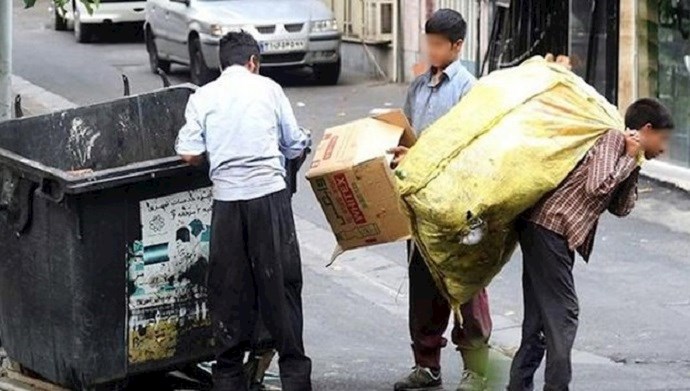Analysis by PMOI/MEK
Iran, January 18, 2021—Over the past ten years, negative economic growth and positive inflation have led to plunge of the value of Iran’s national currency and a sharp decline in the purchasing power of the people, according to a report by the Majlis (parliament) Research Center.
“Statistics on inflation, decline in purchasing power, the devaluation of the national currency, etc., which the Majlis (parliament) Research Center referred to in its report, ‘are worrying and frustrating and show the deterioration of the economic living conditions of the people,’” according to a January 9 report by the Mardomsalari state-run daily.
"The food price index in the first eight months of the Persian calendar year 1398 (March 2019-March 2020) has grown by about 22.5 percent. Meanwhile, in the same period, the food price index has grown by 47 percent… The increase in the food index and the rent fee index in the Persian calendar year 1399 (March 2020-March 2021) has caused the poverty line to increase and certainly the level of poverty in the society has increased. The data also show that the amount of calories consumed by each Iranian has been steadily declining since 2011," the report adds.
The fact is that the plunge of the value of the rial, hunger and the severity of poverty among the people is much worse than what government statistics indicate. In North Khorasan Province, for example, "only four percent of the population does not receive cash subsidies," according to a January 6 by the regime’s semi-official ISNA news agency.
The need of 96 percent of the people for this small amount of 450,000 rials (about $2), with which only a few loaves of bread can be purchased, portrays the poverty among the people of this province.
Regime president Hassan Rouhani claimed at the cabinet meeting: "Since November 2019, we have established a monthly livelihood support package for 60 million people, and we will continue to do that." His remarks were aired by the Shabakeyeh Khabar (News Network) on January 6.
Rouhani's statement means that the 60 million people who need government subsidies are poor and often make ends meet on bread.
In 2017, Parliament Speaker Mohammad Bagher Ghalibaf, who at the time was a presidential candidate, admitted that 96 percent of the population are poor and only a minority of 4 percent live in prosperity.
This is the fate of a country that, with one percent of the world's population, has the second largest gas reserves and the third largest oil reserves in the world. This is country that is one of the lowest and poorest countries in the world in terms of job productivity and people's income because of systematic and governmental corruption, despite having the most fertile land and richest resources in the region.
This is the country with 68 types of non-oil minerals – 37 billion tons of discovered reserves and 57 billion tons of potential reserves among the world's 15 mineral powers. But 75 percent of its population needs the $2 cash subsidy to survive.
According to the state-run media, the misery index is increasing year by year, and since the beginning of 2011, this index has increased dramatically.
Inflation on food and beverages is also increasing month by month and day by day. This inflation has led to the tables of people becoming smaller and emptier.
Regarding the growth of inflation rate and misery index in 2020, Shargh daily reported on October 15: “In 2019, which is the year before seeing the Covid-19 outbreak and its effects on the economy, the 41.2 percent inflation and the 10.7 percent unemployment rate brought the misery index to about 52 percent. In the first half of 2020, the average 28 percent inflation and the average 9.25 percent unemployment rate show a misery index of 37.65 percent, which is about 16 percent higher than the misery index in 2017.”
And this is according to official stats.
According to economist Farshad Momeni, Iran’s misery index has reached 70 percent, as reported by the Khabar Fori website reported on December 11.
In the spring of 2020, the regime’s Statistics Center announced an unemployment rate of 9.8 percent, while at the same time, according to the Majlis (parliament) Research Center, the real unemployment rate was 2.5 times more and was 24 percent.
However, the real unemployment rate is undoubtedly much higher than the rate announced by the Majlis (parliament) Research Center.
Regardless of the economic crises that the Iranian people are facing, the most important reason for the spread of poverty among the people is discrimination in the distribution of income in favor of a government-linked minority and to the detriment of the majority of the poor people.
Changes in the Gini coefficient indicate an increase in inequality in Iran, especially in recent years, and point at an unequal distribution of income. In such circumstances, the minority's share of income is constantly increasing and the share of the deprived majority of society is decreasing. This has led to increased discrimination among the poor majority and their anger at the regime.





